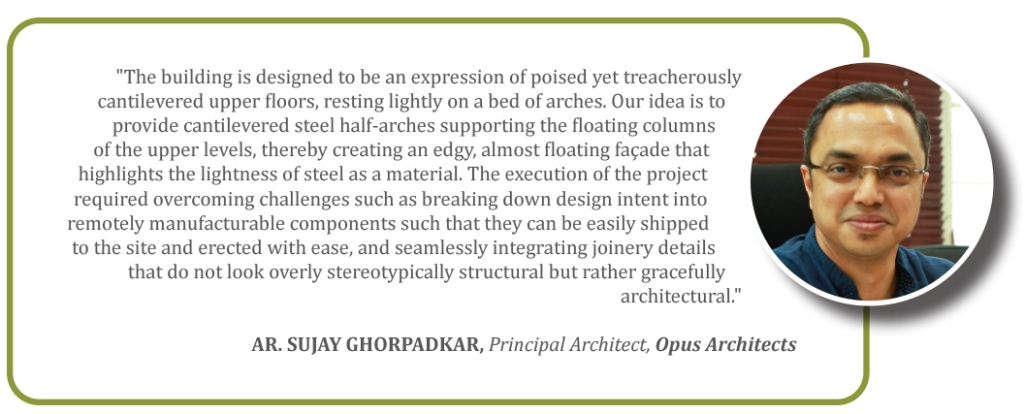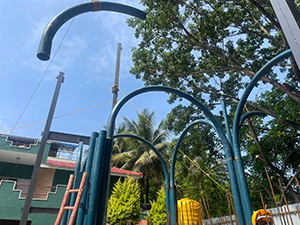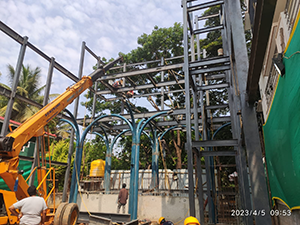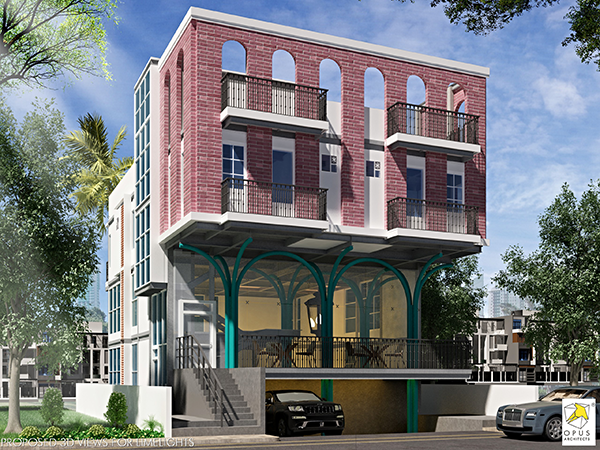Client Brief
The brief for the project was to cater to individuals and families seeking upscale accommodations. The client came to Opus Architects looking to create a space for high-end serviced apartments that offer a unique experience for the guests. The emphasis was on creating spaces that are bespoke and distinct from those currently offered in the market, with a focus on unique design features and amenities that set the building apart from its competitors. The apartments were to be designed with a focus on comfort and luxury, providing all the amenities in compact spaces. Additionally, the client requested the inclusion of a café space as well as a co-working space in the building, thereby providing them with the option to dine and work in-house.

Initial Thought
Upon closely studying and analysing the client’s requirements, we shifted our gears to brainstorming mode. The design process, being an iterative one, took shape with constant collaboration between our team and the client. The idea of bringing the industrial, exposed, uncladded aesthetic of steel was hence explored and found to be the right fit for this project. This design language was carried throughout the building using exposed clay blocks, and concrete floors along with a steel structure.
In an attempt to deviate from the norm of using steel in an ordinary manner, we decided to give the material a retro touch, reminiscent of the Victorian era to some extent. Since similar design attributes are observed in London, we turned to the infamous train stations that had caught our eye during a visit. These Victorian architectural wonders, with their cathedral-like volumes, clustered columns, arches, sense of symmetry, and overall harmony, influenced the creation of steel half-arches throughout our façade. Our primary goal was to make this an integral part of the design in a more contemporary format.


Choice of Material
The introduction and decision to use steel were essential to the design process. By using steel, we could reduce the overall structural footprint of the building, which extended our design flexibility for the rest of the building thus bringing a sense of lightness to the spaces. The unique nature of the material fits perfectly with the client’s requirement to make the building stand out from the crowd. The distinction in form was bought together by the use of steel, for its flexibility and malleability as a material, thus facilitating the unconventional use of arches as structural elements. The same attempt with concrete would have rendered the structure extremely heavy.
Design Language
The architectural design of the building emphasizes the cantilevered upper floors which are delicately balanced on a base of arches. The design concept incorporates cantilevered steel half-arches to support the floating columns of the upper levels, creating a visually striking and contemporary façade. The cantilevered structure is intended to convey a sense of balance while maintaining the necessary structural integrity to ensure the stability of the building.
Architectural Feature
The architectural features of the building showcase a blend of Victorian style with modern elements. The use of Victorian-style arches and railings adds a touch of classic elegance to the structure. Additionally, the large glass windows allow natural light to flood the space, creating a bright and open atmosphere. The concrete floors give a sense of industrialism, while the drama that unfolds owing to the four split levels and interlocking volumes invites spaciousness on a modest floor plan. The building’s design aims to see things as they are, without any embellishments or coverings, highlighting the beauty of the raw materials used. The structure’s minimalist approach is accentuated by the use of plaster, achieving a seamless finish. Overall, the building’s architectural features combine to create a unique and modern aesthetic that is both functional and pleasing.
Software Used
While AutoCAD was used for the 2D drafting, Sketchup was used for the 3D aspects required for the project. FEA and STAAD were used for structural analysis.
Overall Experience
The project presented a unique and exciting challenge, with out-of-the-box requirements that pushed the team to create a new language and structural design. As the master builders of the project, our process involved creating details from scratch, as there were no standard specifications for the joinery details. The execution of the project required overcoming challenges such as bending steel into arches, creating column clusters, breaking down design intent into remotely manufacturable components such that they can be easily shipped to the site and erected with ease, and seamlessly integrating joinery details. It took three months to design the structure and a year to execute the project.





